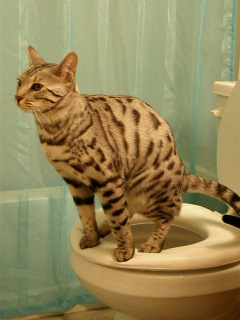Prevent Clogs and Damage: Never Flush Cat Poop Down Your Toilet - Expert Recommendations
Prevent Clogs and Damage: Never Flush Cat Poop Down Your Toilet - Expert Recommendations
Blog Article
What are your thoughts about Can You Flush Cat Poo or Litter Down the Toilet??

Intro
As feline proprietors, it's essential to bear in mind just how we throw away our feline buddies' waste. While it might seem hassle-free to purge feline poop down the bathroom, this practice can have detrimental consequences for both the atmosphere and human wellness.
Ecological Impact
Purging pet cat poop presents harmful microorganisms and parasites into the water system, posturing a considerable risk to marine environments. These impurities can negatively influence marine life and compromise water quality.
Health Risks
In addition to environmental issues, purging feline waste can additionally posture health and wellness risks to human beings. Cat feces may consist of Toxoplasma gondii, a bloodsucker that can cause toxoplasmosis-- a potentially extreme illness, especially for expectant females and individuals with damaged immune systems.
Alternatives to Flushing
The good news is, there are safer and a lot more accountable ways to dispose of feline poop. Take into consideration the following options:
1. Scoop and Dispose in Trash
The most typical method of throwing away pet cat poop is to scoop it right into a naturally degradable bag and toss it in the trash. Make sure to utilize a devoted clutter scoop and throw away the waste promptly.
2. Usage Biodegradable Litter
Go with naturally degradable cat trash made from products such as corn or wheat. These trashes are eco-friendly and can be safely gotten rid of in the trash.
3. Bury in the Yard
If you have a backyard, consider burying pet cat waste in a designated location far from veggie yards and water sources. Be sure to dig deep sufficient to stop contamination of groundwater.
4. Mount a Pet Waste Disposal System
Invest in a pet dog garbage disposal system specifically made for feline waste. These systems make use of enzymes to break down the waste, reducing smell and ecological influence.
Final thought
Responsible pet dog ownership extends past supplying food and sanctuary-- it likewise entails proper waste monitoring. By refraining from flushing pet cat poop down the commode and opting for alternate disposal techniques, we can reduce our ecological footprint and secure human health.
Why Can’t I Flush Cat Poop?
It Spreads a Parasite
Cats are frequently infected with a parasite called toxoplasma gondii. The parasite causes an infection called toxoplasmosis. It is usually harmless to cats. The parasite only uses cat poop as a host for its eggs. Otherwise, the cat’s immune system usually keeps the infection at low enough levels to maintain its own health. But it does not stop the develop of eggs. These eggs are tiny and surprisingly tough. They may survive for a year before they begin to grow. But that’s the problem.
Our wastewater system is not designed to deal with toxoplasmosis eggs. Instead, most eggs will flush from your toilet into sewers and wastewater management plants. After the sewage is treated for many other harmful things in it, it is typically released into local rivers, lakes, or oceans. Here, the toxoplasmosis eggs can find new hosts, including starfish, crabs, otters, and many other wildlife. For many, this is a significant risk to their health. Toxoplasmosis can also end up infecting water sources that are important for agriculture, which means our deer, pigs, and sheep can get infected too.
Is There Risk to Humans?
There can be a risk to human life from flushing cat poop down the toilet. If you do so, the parasites from your cat’s poop can end up in shellfish, game animals, or livestock. If this meat is then served raw or undercooked, the people who eat it can get sick.
In fact, according to the CDC, 40 million people in the United States are infected with toxoplasma gondii. They get it from exposure to infected seafood, or from some kind of cat poop contamination, like drinking from a stream that is contaminated or touching anything that has come into contact with cat poop. That includes just cleaning a cat litter box.
Most people who get infected with these parasites will not develop any symptoms. However, for pregnant women or for those with compromised immune systems, the parasite can cause severe health problems.
How to Handle Cat Poop
The best way to handle cat poop is actually to clean the box more often. The eggs that the parasite sheds will not become active until one to five days after the cat poops. That means that if you clean daily, you’re much less likely to come into direct contact with infectious eggs.
That said, always dispose of cat poop in the garbage and not down the toilet. Wash your hands before and after you clean the litter box, and bring the bag of poop right outside to your garbage bins.
https://trenchlesssolutionsusa.com/why-cant-i-flush-cat-poop/

I ran across that post about How to Dispose of Cat Poop and Litter Without Plastic Bags while browsing on the internet. Are you aware of somebody who is interested by Can You Flush Cat Poo or Litter Down the Toilet?? Please feel free to share it. I love reading our article about Don’t flush cat feces down the toilet.
Give Me A Quote! Report this page